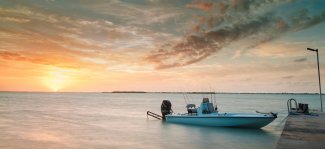Boating isn’t always about going into deep water where you can’t see the bottom for many fathoms. Some fish swim near the shore so you may want to linger along riverbanks instead of venturing out deeper to get the catches you desire. Or you might want to know how to get through patches of shallow water on your way to deeper areas. Either way, navigating shallow water takes some prep work and practice, but we’ve got your back. Gordon Bay Marine is located in Mactier, Ontario, so come to us if you’re looking for boats with shallow draft to get you through the shallows. In the meantime, here are our best tips for navigating shallow water to help you get through the shallows without running aground.
Preparation
Any successful boating excursion begins with proper planning. Make sure you know how to operate your boat, first of all! If you’re in need of a boating course, many are offered by the United States Coast Guard. Next, you should know how to read water depth so that you can adjust your approach when boating in shallow water. You can use plastic coated prints of depth charts or an electronic version that displays the body of water you’re in. This will help you avoid obstacles like sandbars and small islands that lurk right under the surface. Checking the tide charts for the area you’re in will also help you to navigate shallow areas.
Finally, you’ll want to check the weather forecast before you head out on your trip. Heavy rains, high winds, hail and lightning are all far too dangerous for you to navigate, so delay your trip if you see any of this on the forecast. Most small fishing boats aren’t capable of handling rough weather or choppy water.
Watch The Depth
While cruising through the water, make sure you’re aware of your boat’s draft. Draft refers to how high water comes up the sides of your boat, so you want to remain in water that’s deeper than your boat’s draft. If you try to go in shallower water than this, you’re likely to run your boat aground into the riverbank or shoreline. Your boat has a planing hull that sits lower in the water and helps to shift your boat’s draft when you get your boat up to higher speeds, or “on plane.” This lets your boat coast through shallower water, but you’ll still want to remain alert to any potential obstacles in your path. Take things slowly to keep from damaging your boat.
Check the color of the water around you to determine how deep you are. If the color changes suddenly, this reflects a change in depth. Brown or white water indicates that the bottom is very close to the surface, while clear, blue or green water means you’re in sufficiently deep water that you don’t have to worry about running aground. Other indications of shallow water include uneven surface areas or eddies. These visual clues can help you to ascertain your depth when used with your charts.
Drive Responsibly
Just like you’d operate your passenger vehicle in a safe and responsible manner, so should you operate your boat safely and responsibly on the water, no matter the depth. Never use alcohol or recreational drugs while operating a boat, and check with your physician if you’re on any prescription medications that preclude the operation of heavy machinery. Any of these substances can reduce your focus, slow your reflexes and make you more prone to take risks, and all of those things will do you and those around you a serious disservice when it comes to health and safety.
Everyone boarding your boat should know how to swim and float. Life jackets should be provided to all passengers and worn at all times. Carry a throwable life ring to help pull in anyone who falls overboard, and encourage passengers to walk instead of run and be wary of leaning too far over the side of the boat.
When operating your boat, give other watercraft a wide berth and look out for swimmers in the water, watersports users and obstacles that you’ll want to steer around. Go at a reasonable speed and pass other craft to the right while signaling with your horn.
If you still have questions about how best to operate your boat in shallow water, come and talk to the staff at Gordon Bay Marine so we can give you more advice. While you’re here, you can check out our huge selection of fishing boats in many styles, in both new and used condition. We can help you find the perfect boat for your needs and budgetary concerns. We serve the greater Toronto area as well as the neighboring cities of Lake Joseph, Muskoka Lakes and Mississauga, Ontario, with our dealership location in Mactier.
